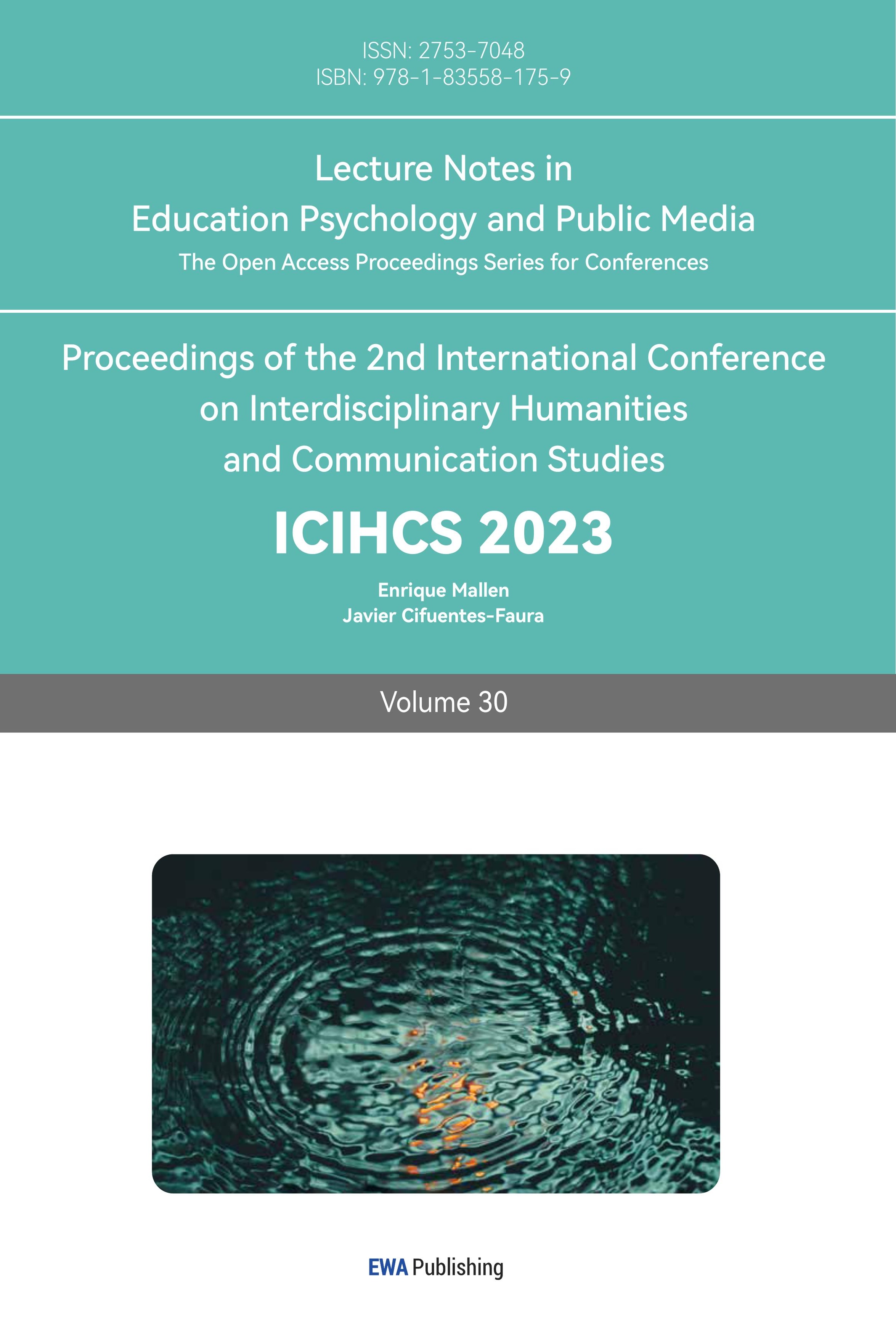1. Introduction
In the realm of video content, background music (BGM, abbreviations will be substituted below) stands as an indispensable element. Amidst various short video platforms, the most prevailing one is a music-oriented short video application affiliated with today’s headlines, known as “TikTok.” This platform boasts an extensive user base, with TikTok’s activity index consistently on the rise, propelling society into the era of short music videos [1]. In the era of burgeoning short videos, led by TikTok, background busic; assumes an increasingly pivotal role. Prior to TikTok’s emergence, no platform had achieved the widespread dissemination of songs on such a scale, extending from short video platforms to major audio and video platforms and social networks, thereby garnering universal attention [2]. TikTok’s BGM exhibits a propensity for infectiousness and popular evolution, causing most of the music to progressively become chart-toppers, steering the course of contemporary trends, and cultivating diversity in aesthetic preferences and inclinations among the populace. Nevertheless, this developmental journey has been fraught with challenges, including the short-lived popularity of hit songs, music misuse, and copyright infringements. Notably, the issues stemming from music misuse, such as producers blindly chasing trends, substantial discord between music and content, and content creators losing their audience, have given rise to skepticism, ennui, and resistance among TikTok’s short video audience, thus obstructing the platform’s progress.
As of today, it is apparent that “music” has nearly become the hallmark of TikTok short video content. Dongdong Qiang also emphasised this point in various external marketing conferences hosted by TikTok: “Let us not forget that TikTok’s very name is synonymous with ‘musical shaking’” [3]. Previous research endeavors have predominantly examined the practical impact of TikTok BGM from the perspective of producers and administrators, with a more pronounced emphasis on the positive influence of TikTok music and relatively less attention paid to the actual auditory and psychological experiences associated with BGM. These studies have predominantly addressed BGM-related issues through a fusion of professional knowledge and analysis conducted via questionnaires, with a less frequent reliance on questionnaire data analysis. By dissecting these issues at the audience level, we gain a more lucid understanding of the effectiveness of BGM presentation. Deriving conclusions from data provides a more pragmatic and subjective approach compared to theoretical analysis. Identifying the drawbacks in the actual presentation’s impact serves as a more effective means to unearth problems and devise solutions.
This paper concentrates on unveiling the misapplications and irregularities surrounding TikTok’s BGM, while also proffering superior strategies and methodologies to mitigate these issues. The objective of this article is to scrutinise the tangible impact of BGM through empirical data gathered via surveys and questionnaires, with the aim of enlightening individuals about the necessity and significance of aligning TikTok’s music with video content.
2. Method
2.1. Data Collection Method
This study employed a questionnaire to survey the participants, resulting in the collection of 305 valid samples. Among these samples, 146 were male, and 159 were female, essentially achieving a 1:1 gender ratio within the study. The demographic of individuals aged 18 to 30, classified as the youth group, constituted half of the total population, amounting to 168 participants. The questionnaire encompassed three main sections aimed at gauging TikTok platform user behavior, their perceptions and satisfaction regarding BGM presentation, and effective improvement measures. These aspects were systematically investigated and examined.
2.2. Field Research
The paper integrates the field research method with the questionnaire data, given the limited sample size obtained through the questionnaire approach. This integration allows for a comprehensive analysis and discussion of audience opinions regarding the appropriateness of music dubbing in TikTok platform video comments. By combining these data sources for analysis, the research progresses seamlessly, enhancing the authenticity and robustness of firsthand information acquisition.
3. Results
The survey encompassed a total of 305 respondents, comprising 146 males and 159 females. Regarding age distribution, there were 168 individuals aged between 18 and 30, 62 adolescents, and 66 adults. It is noteworthy that over half of the entire sample fell within the 18-30 age bracket, while only nine respondents were aged 60 or older, making them non-primary subjects of this investigation. At this current stage, 74 respondents are engaged in educational pursuits, while 215 are actively employed. The remaining participants include retirees and individuals in different life stages, totaling 16. Collectively, these findings contribute to the survey’s robustness by providing insights into gender, age, and occupational diversity.

Figure 1: TikTok usage hours & frequency.
In TikTok, according to the data presented in Figure 1, questions regarding the duration of TikTok usage reveal an overall pattern ranging from six months to three years. As for the frequency of TikTok usage, respondents were categorised into two groups: those who “use it almost daily” and those who “use it 1-4 times per week.” The former group, totalling 234 individuals, falls under the category of “frequent TikTok users,” while the remaining participants are classified as “infrequent TikTok users,” totalling 71 individuals. In summary, the prevailing trend among the surveyed individuals is an extended duration of TikTok usage and increased frequency, facilitating more comprehensive statistical analysis and music-related research.
3.1. High Priority for Background Music

Figure 2: Importance of BGM(1).
The 305 valid questionnaires show that although BGM is not classic and esoteric, its influence on the audience is obvious: people attach great importance and desire to BGM.
As shown in Figure 2, on the question of “Importance” and “Essential” of BGM, more people think that TikTok BGM is “Important and Essential”, and more people think it is “Necessary” than those who think it is “Essential”. Regarding their overall impression of the BGM, more than 200 people thought the TikTok BGM was “Popular or Famous” or “Plain or Accessible”. Only 26 people gave negative ratings, and nearly one in five thought the TikTok BGM was “popular and profound”. Popular music is an important modern cultural phenomenon, closely related to the high intensity of cultural participation and indirectly contributes to the development and change of culture [4], which indicates that the status and weight of BGM in people’s minds is relatively high.
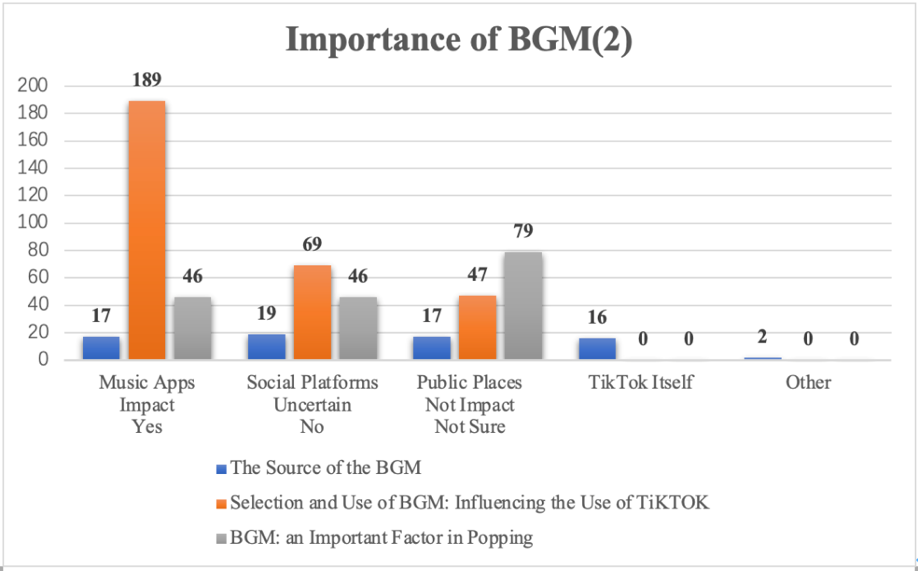
Figure 3: Importance of BGM(2).
Furthermore, the importance of the BGMs of these TikTok videos cannot be overemphasised for both “frequent TikTok swipers” and “infrequent TikTok swipers”, as these BGMs are widely and abundantly available on a variety of platforms.
As shown in Figure 3, it can be seen that people are exposed to the BGM of TikTok videos from a wide range of sources: whether it is music platforms, social software, public places, or TikTok itself, the distribution of values is relatively even, which suggests that some of the BGMs are no longer confined to TikTok itself, but are becoming more and more familiar and influential, and are taking on different forms in different time zones spreading in different forms in different time zones.
In the question on the influence of BGM on the use of TikTok, more than 60% of respondents said that the choice and use of BGM influences their use of TikTok, while only 69% said they were “Not Sure”and 47 said they were “Not Affected”. This suggests that the influence of TikTok BGM is very strong.
Similarly, when asked if “the appropriate use of BGM was a direct factor in the great popularity of TikTok videos,” nearly 60% chose “Yes” and only 40% chose “No” or “Not sure.” Thus, the practical application of TikTok BGM is more effective than the theoretical, and may even be a direct factor in influencing videos to become popular.
3.2. The Importance of Background Music: Already Beyond the Video Content Itself

Figure 4: BGM & content (1).
Through this research, the importance of BGM in TikTok has surpassed the importance of the video content itself, breaking the general rule of video creation that “Content is King” and stimulating the audience’s interest in watching.
Figure 4 examined what people considered to be “The most important sources of attraction for certain types of TikTok videos”. In the questionnaire, 92 people indicated “The Richness and Attractiveness of the Subject Matter or Content of the Video”, 81 indicated “Vividness and Appropriateness of the Music Sound”, and a total of 132 people indicated other factors. It is easy to see from this question that the difference between music elements and video content is very small, and it has become the most important factor other than content or theme.
Based on the above question, we conducted a further survey. When asked “Whether it is easy to guess the content and ending of a video through BGM”, 171 people agreed with this view, only 60 people “Disagreed” and 74 people “Not sure”. This suggests that the use and presentation of BGM are more likely to attract viewers’ attention than the content and production style.
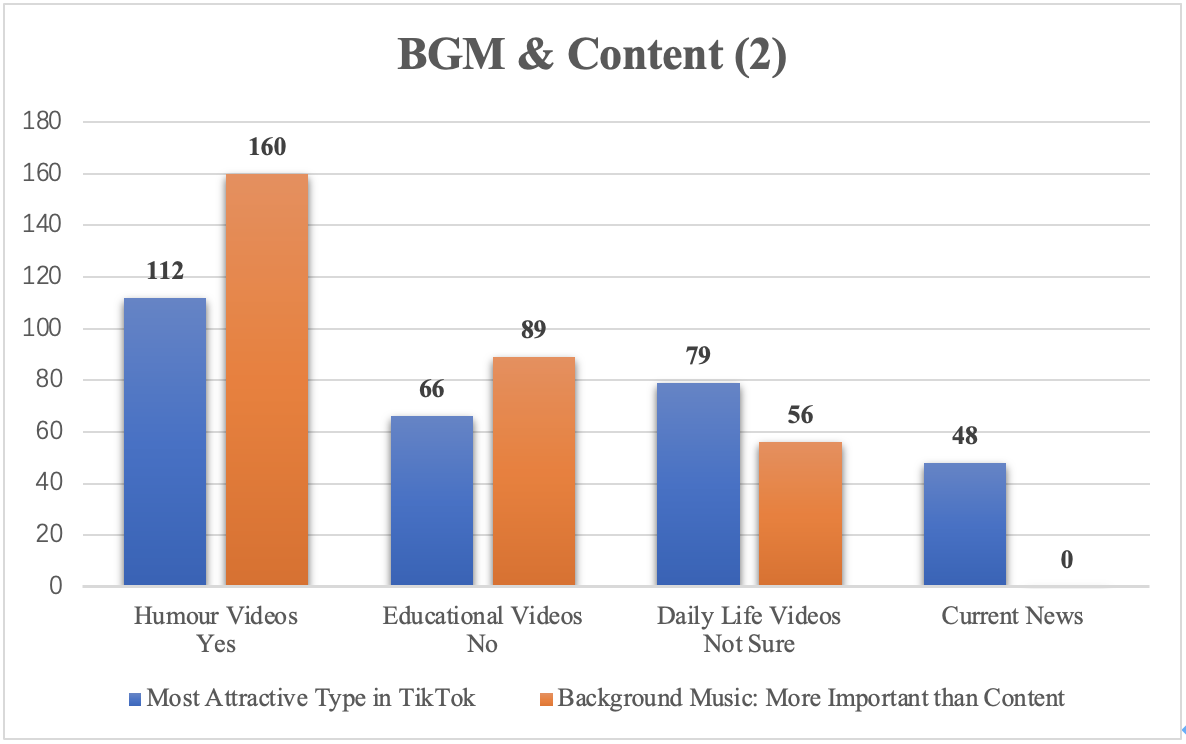
Figure 5: BGM & content (2).
Based on the above findings. This study also conducted a survey, as shown in Figure 5. When asked “the type of video that appeals to you the most on the TikTok platform”, 112 people chose “Humorous Videos”, which is almost 1/3 of the total number of people; “ Educational Videos” and “Daily Videos” were chosen by 66 and 79 people respectively; while “Current News Videos” was chosen by only 48 people. The theory shows that music plays a very important role in humorous videos, while news is more important for real content, reflecting the fact that music is more popular than content on the TikTok platform.
Another more direct question was “ Comparison of the importance of BGM and content”; 160 people (more than half) thought that BGM was more important than content, 89 people disagreed, and 56 people were not sure. This result clearly and directly indicates that the actual effect of BGM is far more important than the content output of the video.
3.3. Background Music: Problematic, but Promising
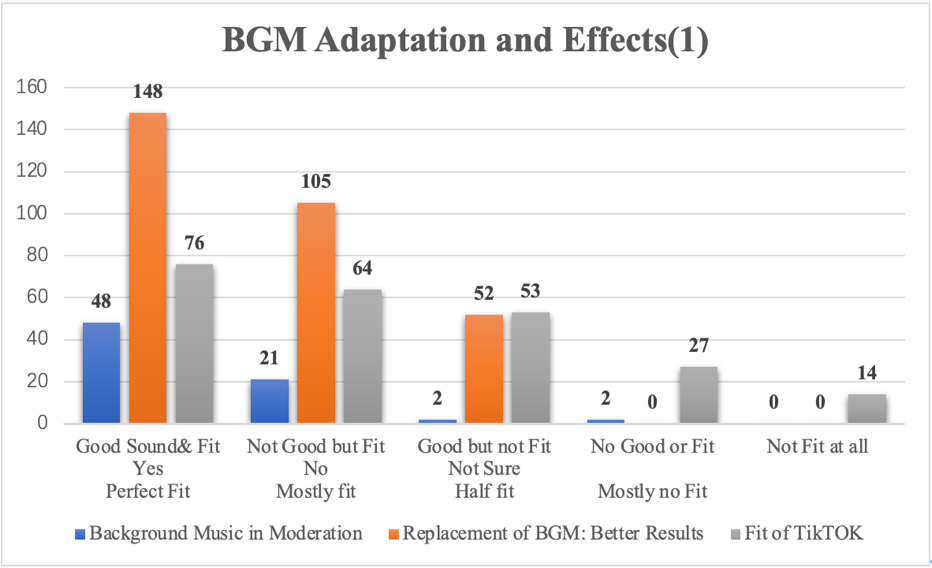
Figure 6: BGM adaptation and effects (1).
Despite the general perception that BGM abuse is a serious problem, there is still confidence and expectation in the future of TikTok BGM.
As shown in Figure 6, on the question of “overall appropriateness of music and videos”, nearly 65% of people think TikTok’s BGM is “Good and Fit”. Only 21% thought it was “Not Good but Fit”, and 2% thought it was “Good but not Fit”. Overall, most respondents think that TikTok’s BGM is suitable for videos, but whether it is good or not is still debatable. However, respondents are basically positive about the efficacy of BGM and compromise on the aesthetics of BGM.
Meanwhile, there is a strange phenomenon when comparing the first two questions in the figure, i.e. when asked whether it is possible to change the BGM to get a better effect of the video, nearly 50% of the respondents think so, only 105 hold the opposite opinion and 52 are not sure.
On the question of the appropriateness of BGM, a large majority thought that the music was generally appropriate, while only 41 people disagreed with this view, and 1/6 were neutral. The results of the experiment suggest that viewers are more tolerant of inappropriate BGM.
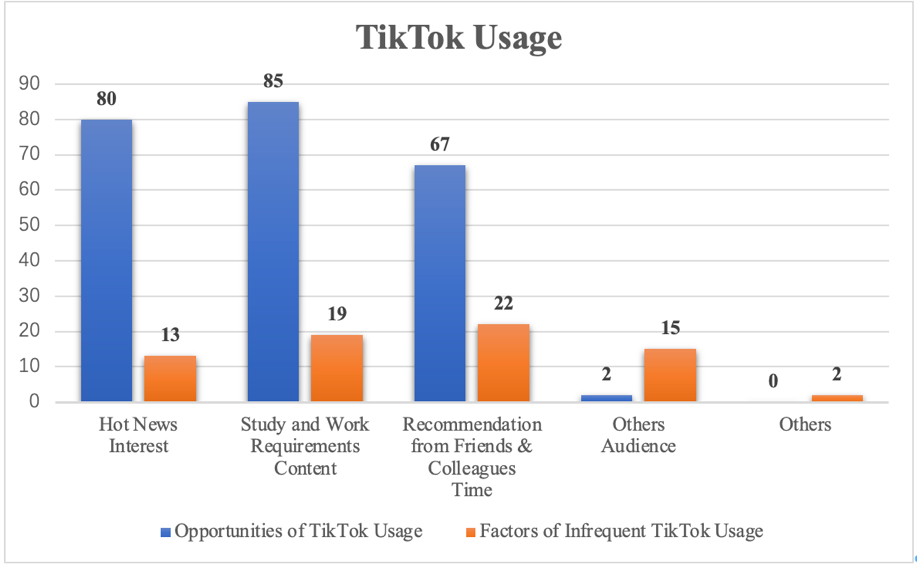
Figure 7: TikTok usage.
As shown in Figure 7, those who “use TikTok frequently” use TikTok more for study and work, as well as to read the latest news, which is an immediate need, while the rest of the population also uses TikTok frequently on the recommendation of their colleagues and friends; whereas those who do not use TikTok frequently are affected by both intrinsic reasons, such as time and interest, and extrinsic reasons, such as the content and the audience. In general, audiences are more likely to be more tolerant of TikTok and its music due to more spontaneous behaviour.
3.4. Effect Guardianship of Background Music: Creators in Charge of a Greater Role
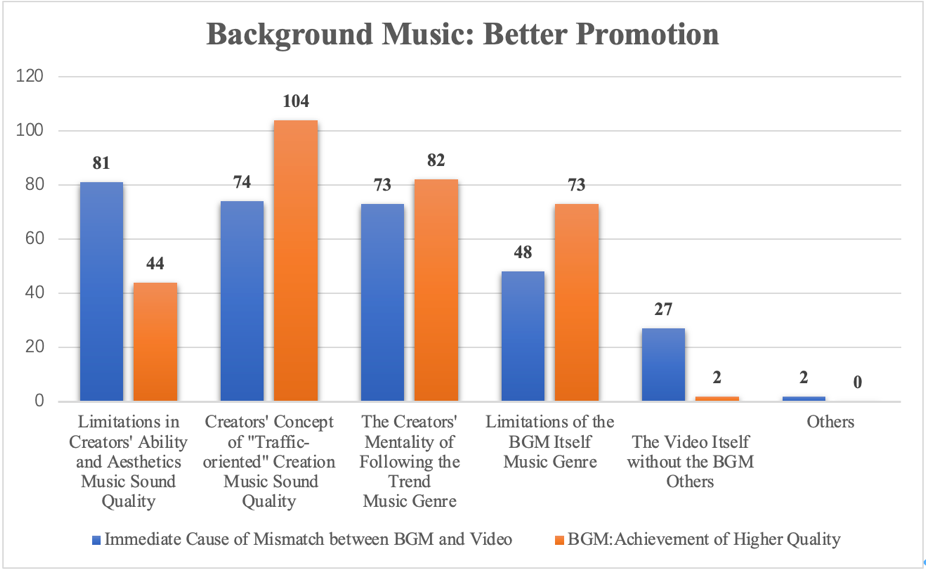
Figure 8: Background music: Better promotion.
Most people believe that audiences should give full play to the feedback function to urge creators to create good works, and platforms should also pay more attention to the role of BGM in videos.
As shown in Figure 8, in the question “In order to improve the overall quality of videos, which aspect of BGM needs to be adjusted and improved the most?”, 34% of respondents chose music length, 73% chose music articulation, and only 126 people chose music sound quality and music genre. Music length” and “music articulation” are the parts that the content producer needs to control and organise. Therefore, the responsibility of the content producer is more important.
When asked about the “most direct reason for the mismatch between BGM and video”, the questionnaire divided the questions into two categories: “creator’s own reason” and “BGM’s own reason”. The number of people who thought that the most direct reason came from the creator was more than 70%, while the number of people who thought that it was BGM and other factors was only 77, which means that most people thought that the reason for the unsatisfactory BGM effect was the BGM itself, suggesting that the majority of people thought that the reason for the unsatisfactory BGM effect was more likely to come from the creator and that it should not be attributed to the BGM itself.
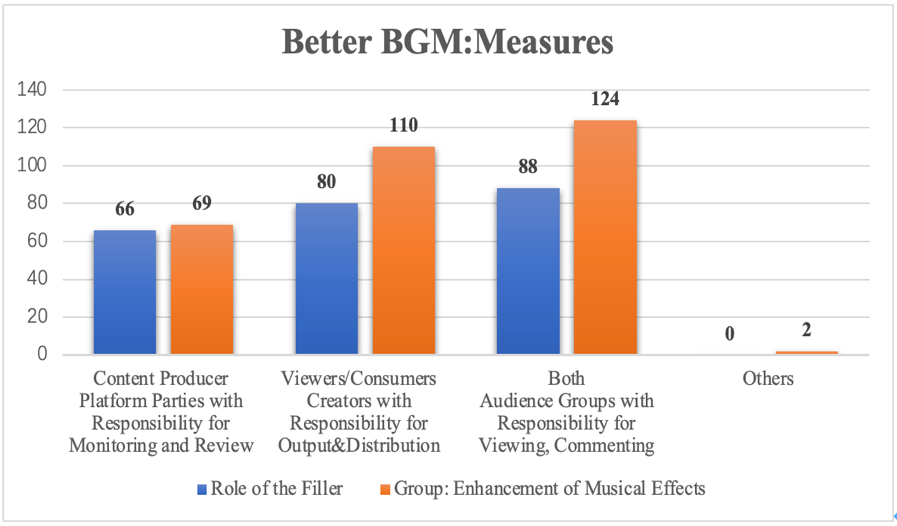
Figure 9: Better BGM: Measures.
As shown in Figure 9, a large portion of the “frequent TikTok users” are content producers and thus have considerable scale and influence in the use and promotion of TikTok music. In terms of the most important group of people who can improve the quality of BGM, 40% of people believe that “viewers” are the most effective in promoting TikTok acoustic music, followed by creators at 36% and platforms at the least.
4. Discussion
4.1. Cause Analysis
There are two main reasons for the above results conclusion:
Firstly, people need highly stimulating short videos in their fast-paced social life. The accelerated pace of people’s lives naturally leads to the strengthening of the trend of “fragmentation” of people’s leisure time [5], so people can recognise and discover the more stimulating short videos. TikTok’s short video platform greatly meets the audience’s need for entertainment with its BGM of strong immersion and interactivity [6]. Thus, when the content has not yet been greatly changed and innovated, the importance of music will exceed the content itself.
Secondly, the emotion people put into using TikTok will influence the tendency of conclusions. It is undeniable that some short videos have obvious emotional tendencies in the process of dissemination, in addition to carrying basic information [7]. At the same time, people’s emotional giving will be fed back in the comment section or digested by themselves. The investigation of the audience always has a subjective colour.
4.2. Suggestions
Based on the aforementioned conclusions, four key suggestions for improvement can be identified.
To begin with, content creators themselves should prioritize personal development and avoid blindly conforming to trends. Self-media creators must enhance their sense of responsibility, produce high-quality videos, and recognize the pivotal role of music. They should take responsibility for both themselves and their audience, employing innovative thinking to craft aesthetically pleasing short videos with sound and visuals. Emphasizing precise account positioning and consistent content updates in line with their chosen theme is crucial. Accumulating a substantial fan base and influence should be an ongoing goal [8].
Furthermore, the audience should adopt a more discerning approach when engaging with the platform, rather than passively consuming content. As the primary viewers and information recipients, the audience holds significant sway in shaping public opinion. In many instances, public opinion monitoring by mass media is an effective problem-solving strategy. Regardless of the industry, entities often struggle when faced with public pressure [9]. Therefore, the audience should possess the ability to identify quality music and content, employing stringent standards to monitor the BGM created by content creators.
Additionally, platform regulators must play a proactive role in monitoring and enforcement. TikTok’s regulators are responsible for maintaining a healthy environment on the platform and preventing the production of videos featuring vulgar music and content due to unhealthy competition.
Finally, TikTok can leverage music as a connecting point to integrate with other platforms. Video viewers experience pleasure and satisfaction when consuming video content, often leading to spontaneous social interactions. Some users even seek out the full versions of music on dedicated music platforms for further enjoyment [10]. By adopting a win-win strategy, TikTok can provide content creators with access to a richer music library. By implementing these four suggestions, TikTok’s short video platform is poised for a qualitative leap in its use of BGM, resulting in more vibrant content that attracts a larger and more engaged audience.
5. Conclusion
In summary, this paper takes music as the starting point, takes the audience as the main research object, and analyses the advantages and disadvantages of the background music presentation effect on TikTok platform and the reasons for its formation. This paper provides a new perspective on the audience level, takes the TikTok platform as a whole, conducts an overview of the effect of music, and finally arrives at a relatively objective result, which supplements the relevant gaps in the study of TikTok music. At the same time, there are also shortcomings in this paper, for example, the single method of investigation, the singularity of the research subject and the subjectivity of the questionnaire will affect the final results of the experiment, resulting in bias and misjudgment. In addition, this paper only discusses the background music issue, and does not make relevant research and elaboration on the sound effects and narrator and other human voices. Therefore, in the future, this study will expand the scope to include the perspectives of supervisors, creators and other groups, and combine psychological, sociological and media theories to analyse and research the various components of music, so as to make the study more systematic and rational, and to draw more authoritative conclusions and more effective solutions.
References
[1]. Zihan Li. (2022). A Study on the Visual Communication of Popular Music on Short Video Platforms--Taking TikTok as an Example. Master’s Thesis of Shandong University. DOI: 10.27272/d.cnki.gshdu.2021.001829.
[2]. Yun Wang. (2020). Analysis of the Application Effect of Background Music in Food Advertisement Design - A review of the Mystery of Food Advertisement. China Brewing, 39(04).
[3]. Yang Su. (2021). Research about the Use of Music for Short Video ads, from the Perspective of Marketing communication--take Douyin for Example Master’s Thesis of Jinan University. DOI: 10.27167/d.cnki.gjinu.2020.001224.
[4]. Shiying Mao.(2023). Seeing Music: the Construction of a New Pattern of Popular Music Communication by TikTok in the View of Media e Ecology. Master’s Thesis of Beijing Foreign Studies University. DOI: 10.26962/d.cnki.gbjwu.2023.000977.
[5]. Huaizhi Chen. (2019). Analysis of Communication Strategies of Music-based Short Videos--Taking TikTok Short Videos as an Example. Master’s Thesis of Guangxi Normal University University.
[6]. Qianying Yan. (2021). A Study on the Popularity Phenomenon of TikTok. Master’s Thesis of Hunan University. DOI: 10.27135/d.cnki.ghudu.2021.002143.
[7]. Xue Liu. (2022). A study on emotional communication of TikTok short videos. Master’s Thesis of Anqing Normal University. DOI: 10.27761/d.cnki.gaqsf.2022.000054.
[8]. Changjun Yang.(2022). Status,Characteristics, and Strategies of Short Video Communication for Public Policy - Taking the Example of Waste Classification on TikTok Platform. Emerging Media, 46-50(24).
[9]. Jian Zhao. (2020). A Discussion on the Influence of Mass Media in the Communication of Popular Music in the New Era. Tomorrow’s Style, 136-137(19).
[10]. Ruibing Han. (2021). Research on the Impact of Emerging Short Video Playing Platforms on Traditional Online Music Platforms. Master’s thesis of Dalian Maritime University. DOI: 10.26989/d.cnki.gdlhu.2020.001375.
Cite this article
Li,Y. (2023). The Study of the Practical Effects of Background Music in TikTok Short Videos. Lecture Notes in Education Psychology and Public Media,30,8-17.
Data availability
The datasets used and/or analyzed during the current study will be available from the authors upon reasonable request.
Disclaimer/Publisher's Note
The statements, opinions and data contained in all publications are solely those of the individual author(s) and contributor(s) and not of EWA Publishing and/or the editor(s). EWA Publishing and/or the editor(s) disclaim responsibility for any injury to people or property resulting from any ideas, methods, instructions or products referred to in the content.
About volume
Volume title: Proceedings of the 2nd International Conference on Interdisciplinary Humanities and Communication Studies
© 2024 by the author(s). Licensee EWA Publishing, Oxford, UK. This article is an open access article distributed under the terms and
conditions of the Creative Commons Attribution (CC BY) license. Authors who
publish this series agree to the following terms:
1. Authors retain copyright and grant the series right of first publication with the work simultaneously licensed under a Creative Commons
Attribution License that allows others to share the work with an acknowledgment of the work's authorship and initial publication in this
series.
2. Authors are able to enter into separate, additional contractual arrangements for the non-exclusive distribution of the series's published
version of the work (e.g., post it to an institutional repository or publish it in a book), with an acknowledgment of its initial
publication in this series.
3. Authors are permitted and encouraged to post their work online (e.g., in institutional repositories or on their website) prior to and
during the submission process, as it can lead to productive exchanges, as well as earlier and greater citation of published work (See
Open access policy for details).
References
[1]. Zihan Li. (2022). A Study on the Visual Communication of Popular Music on Short Video Platforms--Taking TikTok as an Example. Master’s Thesis of Shandong University. DOI: 10.27272/d.cnki.gshdu.2021.001829.
[2]. Yun Wang. (2020). Analysis of the Application Effect of Background Music in Food Advertisement Design - A review of the Mystery of Food Advertisement. China Brewing, 39(04).
[3]. Yang Su. (2021). Research about the Use of Music for Short Video ads, from the Perspective of Marketing communication--take Douyin for Example Master’s Thesis of Jinan University. DOI: 10.27167/d.cnki.gjinu.2020.001224.
[4]. Shiying Mao.(2023). Seeing Music: the Construction of a New Pattern of Popular Music Communication by TikTok in the View of Media e Ecology. Master’s Thesis of Beijing Foreign Studies University. DOI: 10.26962/d.cnki.gbjwu.2023.000977.
[5]. Huaizhi Chen. (2019). Analysis of Communication Strategies of Music-based Short Videos--Taking TikTok Short Videos as an Example. Master’s Thesis of Guangxi Normal University University.
[6]. Qianying Yan. (2021). A Study on the Popularity Phenomenon of TikTok. Master’s Thesis of Hunan University. DOI: 10.27135/d.cnki.ghudu.2021.002143.
[7]. Xue Liu. (2022). A study on emotional communication of TikTok short videos. Master’s Thesis of Anqing Normal University. DOI: 10.27761/d.cnki.gaqsf.2022.000054.
[8]. Changjun Yang.(2022). Status,Characteristics, and Strategies of Short Video Communication for Public Policy - Taking the Example of Waste Classification on TikTok Platform. Emerging Media, 46-50(24).
[9]. Jian Zhao. (2020). A Discussion on the Influence of Mass Media in the Communication of Popular Music in the New Era. Tomorrow’s Style, 136-137(19).
[10]. Ruibing Han. (2021). Research on the Impact of Emerging Short Video Playing Platforms on Traditional Online Music Platforms. Master’s thesis of Dalian Maritime University. DOI: 10.26989/d.cnki.gdlhu.2020.001375.





